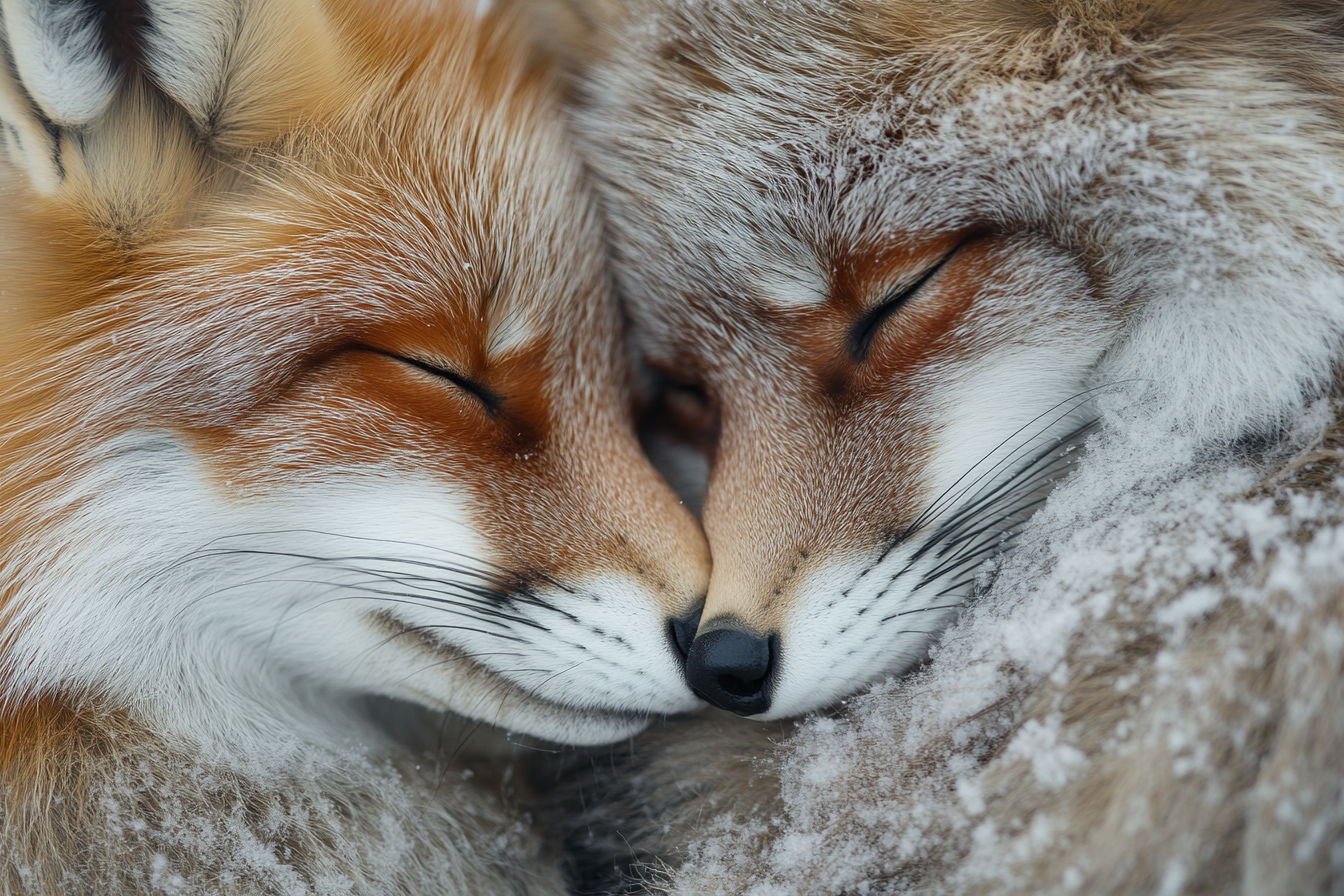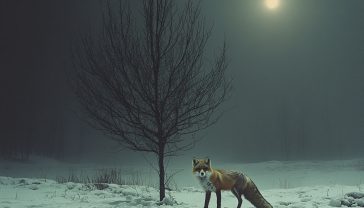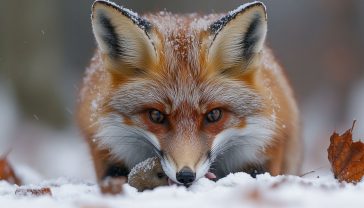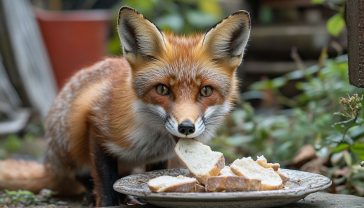A Fox’s Tale: The Secretive Love Lives of Britain’s Most Cunning Neighbours
A comprehensive guide to the mating rituals of the UK’s red fox, from the piercing screams of a vixen in winter to the tender care of cubs in spring.

This post may contain affiliate links. If you make a purchase through these links, we may earn a commission at no additional cost to you.
It’s a sound that can curdle the blood. A piercing, almost human-like scream tearing through the stillness of a January night. If you’ve heard it, you don’t forget it. Many Brits, hearing it for the first time from their cosy suburban beds, have imagined all sorts of horrors unfolding in the darkness. But this isn’t the sound of a creature in distress. It’s the sound of love. Or, at least, the very loud, very dramatic prelude to it.
This is the vixen’s call, the opening act in one of Britain’s most fascinating and often misunderstood wildlife dramas: the mating rituals of the red fox (Vulpes vulpes).
For most of the year, foxes are ghosts. We catch fleeting glimpses of them—a flash of a bushy tail disappearing over a fence, a pair of amber eyes caught in our headlights. They are masters of the unseen, trotting through our world on silent paws. But in the dead of winter, everything changes. Their hormones surge, their territorial instincts sharpen, and their secretive lives suddenly become very, very noisy.
This guide pulls back the curtain on the complex and captivating world of fox courtship. It’s a story of powerful scents, intricate communication, fierce competition, and surprisingly tender moments. From the first flirtatious calls echoing across frosty fields to the dedicated parenting that follows, we’ll explore the complete annual cycle of the red fox. Forget the cartoon villain or the cunning pest of folklore; the real story of how foxes find a mate and raise a family is far more compelling. It’s a tale of survival, instinct, and a little bit of wild magic, playing out right on our doorsteps.
The Fox’s Calendar: A Year in the Life
To understand a fox’s love life, you first need to understand its calendar. Unlike us, their lives are dictated not by months and dates, but by the rhythm of the seasons. Their entire year revolves around one critical event: successfully raising the next generation of foxes. This drive shapes their behaviour, their diet, and their social lives.
Think of the fox’s year as a four-act play, with mating season as the explosive climax.
Act 1: Autumn (September – November) – The Build-Up
As the leaves turn gold and the nights draw in, a change comes over the fox world. The cubs born in the spring are now teenagers, almost fully grown. It’s time for them to leave home. This period is known as dispersal. The young dog foxes (males), in particular, are driven out by their fathers to find their own patch of land. Vixens (females) might hang around a little longer, sometimes staying to help raise their mother’s next litter, but many of them will also strike out on their own.
This is a time of exploration and territorial marking. Foxes aren’t just wandering aimlessly; they are scouting for a place with a good food supply and suitable den sites. They lay down the law of their new territory using powerful chemical signals. They leave their scent on prominent objects—a tuft of grass, a fence post, a discarded crisp packet—using urine and special glands on their paws and tail.
It’s basically the fox equivalent of graffiti tagging, a series of “I was here” messages that other foxes can read loud and clear. This scent-marking isn’t just about territory; it’s a fox’s personal profile, communicating its sex, health, and social status.
Act 2: Winter (December – February) – The Mating Game
This is when things really kick off. As winter deepens, the vixen’s hormones ramp up, and she becomes receptive to mating for only a few days each year. Her scent changes, sending out an irresistible signal to every dog fox in the neighbourhood. This is the trigger for the peak mating season, which in Britain typically falls in January.
The nights are filled with sound. The dog foxes, now pumped full of testosterone, roam far and wide, their territorial squabbles escalating into noisy, tooth-baring conflicts. They bark, they yelp, and they make a guttural “gekkering” sound during confrontations.
And above it all is that unforgettable scream of the vixen. This isn’t a scream of pain; it’s a contact call. She is announcing her readiness to the world. It’s a powerful, long-distance message designed to attract males from all over. The dog foxes will answer with their own sharp, triple-bark calls. It’s a noisy, frantic, and absolutely vital conversation happening in the dark.
Act 3: Spring (March – May) – The Nursery
After the chaos of mating season, a period of relative calm descends. The pregnant vixen, with a gestation period of around 53 days, prepares her den, known as an earth. She’ll either dig a new one or, more commonly, clean out and enlarge an existing one. These can be surprisingly complex, with multiple entrances and chambers. In our towns and cities, a cosy spot under a garden shed or a quiet corner of an allotment often does the trick.
In late March or early April, she gives birth to a litter of four or five cubs. They are born blind, deaf, and covered in dark, chocolate-brown fur. They are utterly helpless and completely dependent on their mother for warmth and milk. The dog fox plays a crucial role here. He doesn’t enter the den, but he acts as the provider, a loyal partner hunting for the vixen and bringing food back for her. He’s the original Deliveroo driver, ensuring his family is fed while the vixen focuses on nursing the cubs.
Act 4: Summer (June – August) – Growing Up Fast
By summer, the den is a hub of activity. The cubs, now looking more like miniature versions of their parents, start to explore the world outside. This is a time of play and learning. They pounce on each other, chase insects, and practice their hunting skills on anything that moves. This play isn’t just for fun; it’s a vital part of their education, teaching them the skills they’ll need to survive.
Their parents work tirelessly to keep their hungry mouths fed, bringing back everything from pigeons and rats in the city to rabbits and beetles in the countryside. As summer ends, the cubs are becoming independent, and the cycle is ready to begin all over again.
Speaking the Language of Love: Scent and Sound
Foxes don’t use dating apps or send flirty texts. Their communication is far more primal and sophisticated. They rely on two main channels to find a partner and defend their territory: scent and sound.
The Power of Scent: A Chemical Conversation
A fox’s world is a world of smells. Their sense of smell is incredibly acute, and they use it to read the story of the landscape. Scent is their newspaper, their social media feed, and their passport all rolled into one.
Key Scent Glands
Foxes have several specialised glands that produce their unique chemical signatures:
- The Vio Gland: Located on the upper surface of the tail, about a third of the way down. You can often spot it as a dark patch of fur. This gland produces a scent that some people describe as smelling like violets, hence the name. Its exact function is still debated by scientists, but it’s thought to be an important part of individual recognition.
- Anal Glands: Like many carnivores, foxes have glands around their anus that secrete a powerful, musky fluid. This is a key component of their faeces (known as scat), turning each dropping into a territorial marker.
- Paw Glands: Glands between their toes leave a scent trail wherever they walk, helping them navigate their own territory and letting other foxes know who has passed by.
Urine: The Ultimate Status Update
Urine is the most important tool in a fox’s scent-marking toolkit. Both males and females use it, but the dog fox is a particularly enthusiastic sprayer during the mating season. He will spray urine on prominent objects along his patrol route—a behaviour known as cocked-leg urination.
This isn’t just a simple “keep out” sign. The chemical compounds in the urine convey a huge amount of information:
- Identity: Each fox has a unique scent.
- Sex: A vixen can tell if the marker was left by a dog fox or another female.
- Reproductive Status: Crucially, during winter, the vixen’s urine contains hormones that signal she is coming into oestrus (her fertile period). This scent is what drives the dog foxes wild.
- Health and Diet: A strong, potent scent can indicate a healthy, well-fed male—a desirable trait in a potential mate.
By sniffing a scent mark, a fox can build a detailed picture of the individual who left it, all without ever seeing them. It’s an incredibly efficient way to communicate across a wide area.
The Sounds of the Night: A Vocal Courtship
While scent is subtle and lingering, vocalizations are immediate and dramatic. The winter soundscape of fox territory is rich with calls, each with a specific meaning.
The Vixen’s Scream
This is the most famous and startling of all fox calls. It’s a high-pitched, drawn-out shriek that can sound unnervingly human. As we’ve learned, this is the vixen’s way of advertising her availability. It’s most common in the dead of night from December to February. A vixen in heat is a powerful magnet, and this call is designed to draw in males from the surrounding area.
The Dog Fox’s Bark
The male’s response is a sharp, “wow-wow-wow” bark. It’s a shorter, more percussive sound than the vixen’s scream. It functions as both a contact call and a warning. When a dog fox hears a vixen’s scream, he may bark in response to locate her. He also uses it to challenge rival males who are trespassing on his patch. A series of barks can be a declaration of ownership: “This is my territory, and that vixen is mine!”
Gekkering and Yelping
These are the sounds of close-quarters conflict. Gekkering is a rattling, stuttering call made during aggressive encounters, often between two rival males competing for a female. It sounds a bit like a machine gun or a football rattle. It’s often accompanied by posturing, chasing, and sometimes, real fights.
Yelps and whimpers are used as sounds of submission, often by a subordinate fox to a more dominant one.
This combination of screams and barks creates a nocturnal dialogue. It allows foxes to find each other, assess potential mates, and warn off rivals, all under the cover of darkness.
The Courtship: From First Date to Pair-Bond
Once a dog fox has located a receptive vixen, the courtship proper can begin. This isn’t a simple case of “boy meets girl.” It’s a cautious, often lengthy process of building trust and assessing compatibility. The vixen is in control; she decides which male is worthy of fathering her cubs.
The Initial Encounter
The male will approach the female cautiously. He needs to signal his romantic intentions, not aggression. He’ll often hold his body low to the ground, with his ears flattened and his tail held low, all signs of submission. He might whimper softly.
The vixen will likely be wary at first. She might greet his advances with a snap or a warning growl. This is her testing him. A male who is too aggressive or too timid is unlikely to be a good partner and provider. He must be persistent but respectful.
A Game of Chase
If the vixen is interested, a period of playful interaction often follows. This can involve games of chase, where she’ll lead him on a merry dance around their territory. They will circle each other, wagging their tails. He might offer her gifts of food. These interactions can go on for several days, sometimes even weeks before the peak of her fertility.
This isn’t just fun and games. During this time, they are getting to know each other’s scent and strengthening their bond. They will groom each other, sniff each other intently, and spend more and more time in close proximity.
The Copulatory Lock
When the vixen is finally ready to mate, the act itself is a noisy and vigorous affair. Fox mating is famous for one peculiar feature: the copulatory lock or tie.
After the male has mounted the female, a part of his penis called the bulbus glandis swells, locking him inside the vixen. The two foxes remain physically tied together for anywhere from 20 minutes to over an hour. During this time, they will often turn to face in opposite directions, standing back-to-back.
This might look strange, even alarming, to a human observer, but it serves a vital biological purpose. The tie ensures that the male’s sperm has the maximum possible chance of fertilising the vixen’s eggs. It also prevents other males from mating with her immediately afterwards, increasing his chances of being the father.
Monogamy and Mates: The Fox Family Unit
Are foxes faithful? It’s a complex question. They are often described as monogamous, and it’s true that a dominant dog fox and vixen will form a strong pair-bond that can last for several years, sometimes for life. This pair forms the core of a family group.
However, the reality on the ground can be a bit more complicated, especially in areas with high fox populations, like our cities.
- The Classic Pair: In many territories, especially in rural areas, a single male and female will work together to raise their litter. The dog fox is a dedicated partner, hunting for the vixen and helping to feed the cubs once they are weaned.
- Urban Complexities: In cities, where territories are smaller and food is abundant, fox society can be more complex. A territory might be controlled by a dominant pair, but it might also include subordinate vixens, often daughters from a previous litter. These “helpers” usually don’t breed themselves but play a vital role in bringing up the dominant vixen’s cubs. It’s like having built-in babysitters.
- Extra-Pair Liaisons: DNA studies have revealed that things aren’t always as they seem. Sometimes, a litter of cubs can have more than one father. A vixen might mate with her primary partner but also have a sneaky encounter with a neighbouring male. Likewise, a dominant dog fox might father cubs with vixens in adjoining territories.
So, while the primary social unit is the pair-bond, focused on raising cubs, a bit of infidelity is not uncommon. From a genetic perspective, it makes sense: it increases the diversity of the gene pool.
Raising the Next Generation: Life in the Den
The end of the mating season is just the beginning of the real work. The ultimate goal of all this frantic activity is to produce healthy, successful offspring.
Preparing the Earth
The vixen is solely responsible for preparing the den. She seeks out a site that is dry, sheltered, and safe from predators (and humans). In the countryside, this might be a burrow in a sandy bank or under the roots of a tree. In urban areas, the options are more varied:
- Under garden sheds
- In compost heaps
- Beneath decking
- In quiet, overgrown corners of parks or railway embankments
She cleans out the tunnels and the main chamber, creating a safe and warm nursery for her impending arrivals.
Birth and Early Days
The cubs—usually four or five of them—are born tiny, weighing only about 100 grams. They are completely helpless, relying on their mother’s body heat and milk. The vixen will rarely leave them for the first couple of weeks.
This is when the dog fox comes into his own. He is the family’s sole provider. He tirelessly patrols their territory, hunting and scavenging, and brings food back to the entrance of the den for the vixen. This is a critical period; if something happens to the dog fox, the litter is unlikely to survive.
Emerging into the World
At around four weeks old, the cubs’ eyes are open, their dark fur is being replaced by the classic red coat, and their curiosity is growing. They take their first wobbly steps out of the den into the sunshine.
The area around the den entrance becomes their playground. This is a crucial time for their development. Through play-fighting with their siblings, they learn social etiquette, establish a pecking order, and practice the skills of biting and chasing.
Their diet also changes. The vixen starts to wean them off milk, and both parents bring them solid food. At first, this is pre-digested and regurgitated, but soon they are bringing them small prey items. You can often tell if a den is active by the signs around the entrance: feathers, bones, and sometimes, the odd stolen shoe or gardening glove that a cub has decided is a fun toy.
The Weaning and Dispersal
Throughout the summer, the parents lead the cubs on their first hunting trips, teaching them how to find food and avoid danger. By the time autumn arrives, the cubs are almost fully grown and capable of fending for themselves.
This is when the family unit begins to break down. Hormonal changes in the parents, particularly the father, trigger aggression towards the young males. This forces them to disperse and find territories of their own, preventing inbreeding and ensuring the genes are spread far and wide. The cycle is now complete, ready to begin again with the onset of winter.
Urban Foxes: Love in the Big City
The story of the red fox in Britain over the last century is a story of incredible adaptation. Foxes have not just survived in our towns and cities; they have thrived. This urban environment has had a fascinating impact on their mating rituals and social lives.
Smaller Territories, More Neighbours
In the countryside, a fox territory can be several square kilometres. In a city like London or Bristol, it can be just a few dozen back gardens. This high-density living means foxes are constantly interacting with their neighbours.
This leads to:
- More Social Complexity: Urban fox groups are often larger and more complex than their rural counterparts. A single territory might contain not just the dominant pair but also several non-breeding subordinate adults, creating a more communal living arrangement.
- Increased Competition: With so many foxes in a small area, competition for mates during the winter can be intense. This is why urban areas can be particularly noisy during January, with the screams, barks, and fighting calls of numerous rivals echoing among the houses.
A Different Diet, A Different Lifestyle
Urban foxes have a famously varied diet. They will eat everything from birds and rats to discarded takeaways and food deliberately left out for them in gardens. This reliable, year-round food source means they are generally healthier and can support larger litters.
However, it also brings them into closer contact with humans, which presents its own challenges. While many people love their local foxes, others see them as a nuisance. This relationship with humanity is now a key factor in the life of an urban fox.
The Future of the British Fox
The red fox is a true survivor. It has adapted to every change we have thrown at the British landscape, from the clearing of forests to the building of motorways. Their mating rituals, honed by thousands of years of evolution, are a perfect example of this resilience.
The piercing scream on a winter’s night is not something to be feared. It is a raw, wild, and beautiful sound. It’s a reminder that even in our modern, crowded island, nature’s ancient dramas are still playing out all around us. It is the sound of a family beginning, a testament to the enduring spirit of one of Britain’s most intelligent and adaptable creatures. So next time you hear it, don’t be alarmed. Just pull the duvet a little tighter, smile, and appreciate the sound of fox love in the air.
Further Reading
For those interested in delving deeper into the lives of British foxes, these resources are highly recommended:
- The Fox Website: An incredibly detailed and scientifically grounded resource run by wildlife biologist Dawn Scott.
- The Wildlife Trusts: Offers excellent information on British wildlife, including local fox populations and conservation efforts.
- The Mammal Society: A charity dedicated to the study and conservation of British mammals, providing authoritative fact sheets on the red fox.
- BBC Wildlife Magazine: Frequently features articles and photography on British foxes, written by leading experts.






